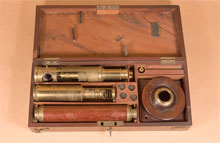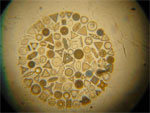 |
|||||
 |
 |
||||
 |
|||||
 |
 |
||||
Scioptic Ball Microscope Compendium (No. 260 ) |
||||||||||||
 |
Age: 1740–1750 Made by: unknown Made in: probably England |
|||||||||||
 |
||||||||||||
|
The components fit into this mahogany case.
|
||||||||||||
 |
||||||||||||
|
Imaging
|
||||||||||||
|
This microscope compendium consists of a box of instruments that includes a Drum microscope, a Screw-barrel microscope, a Telescope, and a Scioptic ball. The telescope and screw-barrel microscope are components of a projection system much like the solar microscope of a later era. The ball mount would have been attached to an outside wall with the opening facing the sun. The other opening could accommodate either the telescope or the screw-barrel microscope. By loosening the retaining ring on the mount, the ball could be rotated, allowing the instrument to follow the sun for maximum illumination. The telescope was used to image sunspots, or possibly outdoor scenes. It has the typical complement of three lenses and thus inverts an image. However, the outer tube contains a fourth (positive) lens, the function of which is to invert the final (telescope) image to project an upright image. The telescope is 15cm long with inner tube retracted. A second microscope included with this compendium is a typical Wilson-type screw-barrel magnifier. It would have been used as a projection microscope by mounting it on a brass tube, then threading the end onto the scioptric ball. In this configuration it acts as a projection system for slide mounted specimens. Illumination would have been the sun. The instrument is 17cm tall. The third optical component is a typical drum-type compound microscope. It comes with two objectives and an illuminating mirror for imaging samples with transmitted light. It is 22–24cm tall. In about 1750 Benjamin Martin offered a compendium of instruments in a single case, such as is displayed here, described as a Cabinet of Optical Instruments. It included a scioptic ball, drum microscope, screw-barrel microscope and telescope. Scioptic balls first appeared around 1740, and were offered by Benjamin Martin, John Cuff, and (possibly) Lieberkuhn. Scioptic balls were an evolutionary step between the Camera Obscure, Magic Lantern, and Solar microscope (with fixed tube and moveable mirror) as designed by John Cuff in 1743*. |
||||||||||||
| Featured 05/2007
*Clay and Court, 1932 |
||||||||||||